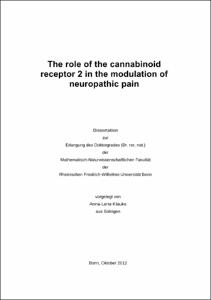Klauke, Anna-Lena: The role of the cannabinoid receptor 2 in the modulation of neuropathic pain. - Bonn, 2013. - Dissertation, Rheinische Friedrich-Wilhelms-Universität Bonn.
Online-Ausgabe in bonndoc: https://nbn-resolving.org/urn:nbn:de:hbz:5n-34063
Online-Ausgabe in bonndoc: https://nbn-resolving.org/urn:nbn:de:hbz:5n-34063
@phdthesis{handle:20.500.11811/5791,
urn: https://nbn-resolving.org/urn:nbn:de:hbz:5n-34063,
author = {{Anna-Lena Klauke}},
title = {The role of the cannabinoid receptor 2 in the modulation of neuropathic pain},
school = {Rheinische Friedrich-Wilhelms-Universität Bonn},
year = 2013,
month = nov,
note = {Neuropathic pain is a debilitating, chronic pain condition associated with inflammation or injury of peripheral and central nerves (Milligan and Watkins, 2009). The existing pharmacotherapies either lead to an inadequate pain relief or have psychomimetic side effects. Therefore, selective agonists targeting the peripherally expressed cannabinoid receptor 2 (CB2) came into the focus for the treatment of neuropathic pain and a number of studies have shown that CB2 is critically involved in the modulation of neuropathic pain responses. Recently, the widespread plant volatile ß-caryophyllene (BCP) was identified as a natural, selective CB2 receptors agonist, which is found in relatively high concentrations in many spice and food plants.
The present study demonstrates that orally administered BCP ameliorated thermal hyperalgesia and mechanical allodynia in mice suffering from neuropathic pain with no cannabinoid-induced psychomimetic side effects. The pharmacological effects of BCP were mediated by CB2 receptors. Similarly, histological analyses revealed that BCP reduced the inflammatory response (glia activation) in the dorsal horns of lumbar spinal cord. Thus, the natural plant product BCP may be highly effective in the treatment of long lasting, debilitating pain states and highlights the role of dietary factors in the development and modulation of chronic pain conditions.
Further, a second model for peripheral nerve injury was established. Repeated treatment with the chemotherapeutic agent paclitaxel induced a robust decrease of mechanical withdrawal latencies in CB2 receptor knockout mice. Wild type littermates in contrast showed less signs of neuropathic pain. These results suggest that CB2 receptor activation might protect against chemotherapeutic agent-induced neuropathic pain.
Taken together, both experimental approaches emphasize the important role of CB2 receptors in the control of neuropathic pain and their relevance as a possible therapeutic target to improve current neuropathic pain therapies.},
url = {https://hdl.handle.net/20.500.11811/5791}
}
urn: https://nbn-resolving.org/urn:nbn:de:hbz:5n-34063,
author = {{Anna-Lena Klauke}},
title = {The role of the cannabinoid receptor 2 in the modulation of neuropathic pain},
school = {Rheinische Friedrich-Wilhelms-Universität Bonn},
year = 2013,
month = nov,
note = {Neuropathic pain is a debilitating, chronic pain condition associated with inflammation or injury of peripheral and central nerves (Milligan and Watkins, 2009). The existing pharmacotherapies either lead to an inadequate pain relief or have psychomimetic side effects. Therefore, selective agonists targeting the peripherally expressed cannabinoid receptor 2 (CB2) came into the focus for the treatment of neuropathic pain and a number of studies have shown that CB2 is critically involved in the modulation of neuropathic pain responses. Recently, the widespread plant volatile ß-caryophyllene (BCP) was identified as a natural, selective CB2 receptors agonist, which is found in relatively high concentrations in many spice and food plants.
The present study demonstrates that orally administered BCP ameliorated thermal hyperalgesia and mechanical allodynia in mice suffering from neuropathic pain with no cannabinoid-induced psychomimetic side effects. The pharmacological effects of BCP were mediated by CB2 receptors. Similarly, histological analyses revealed that BCP reduced the inflammatory response (glia activation) in the dorsal horns of lumbar spinal cord. Thus, the natural plant product BCP may be highly effective in the treatment of long lasting, debilitating pain states and highlights the role of dietary factors in the development and modulation of chronic pain conditions.
Further, a second model for peripheral nerve injury was established. Repeated treatment with the chemotherapeutic agent paclitaxel induced a robust decrease of mechanical withdrawal latencies in CB2 receptor knockout mice. Wild type littermates in contrast showed less signs of neuropathic pain. These results suggest that CB2 receptor activation might protect against chemotherapeutic agent-induced neuropathic pain.
Taken together, both experimental approaches emphasize the important role of CB2 receptors in the control of neuropathic pain and their relevance as a possible therapeutic target to improve current neuropathic pain therapies.},
url = {https://hdl.handle.net/20.500.11811/5791}
}






